
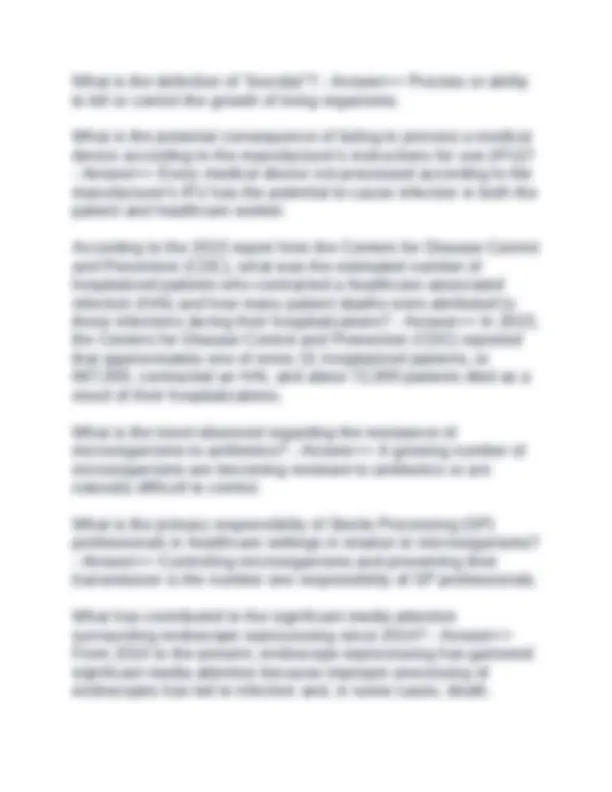
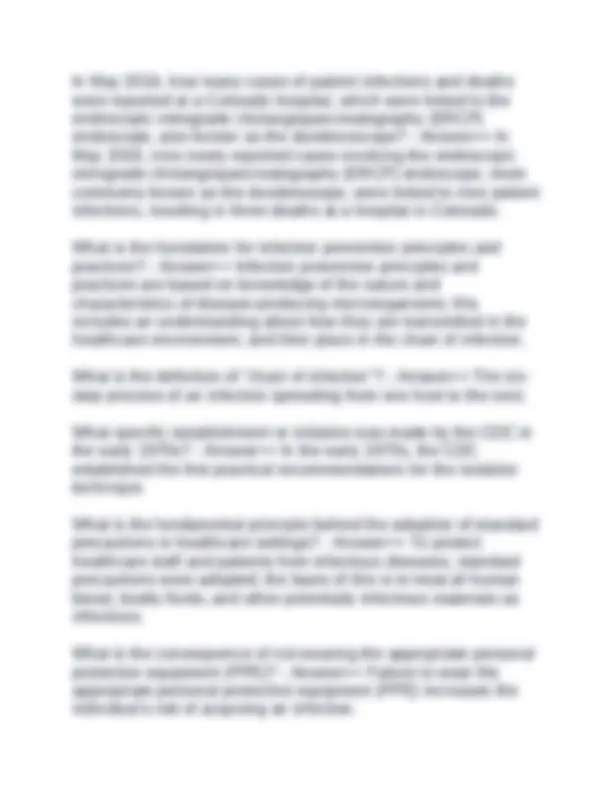
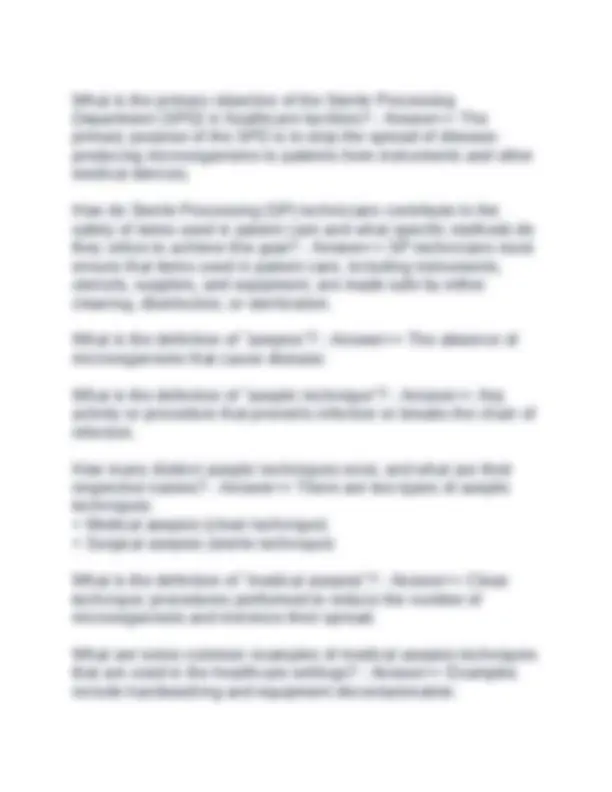
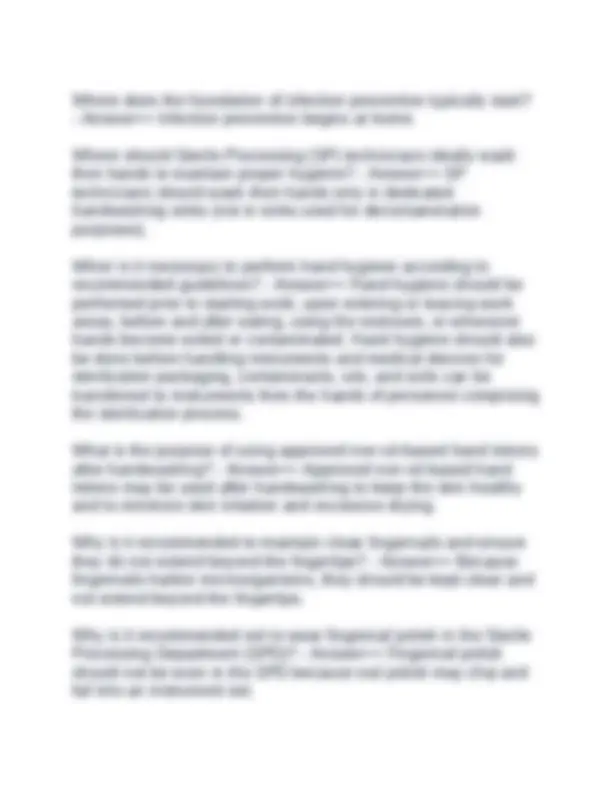
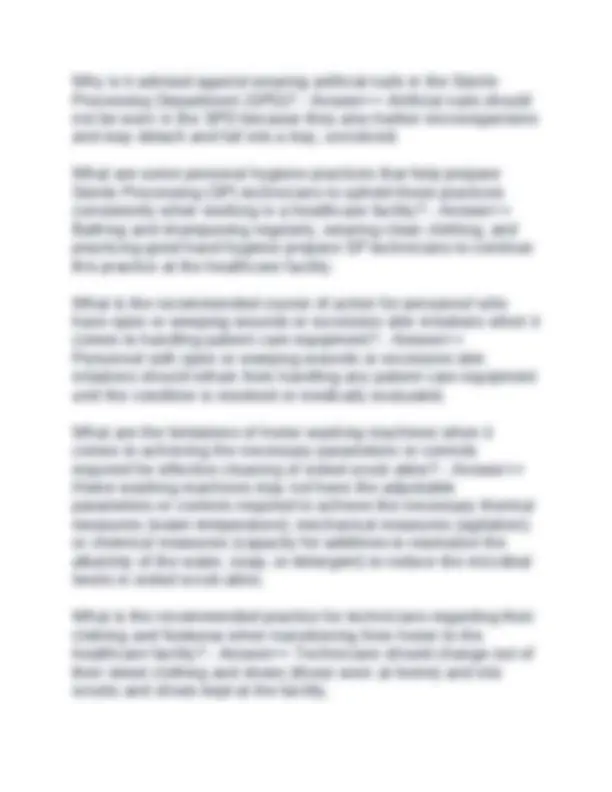
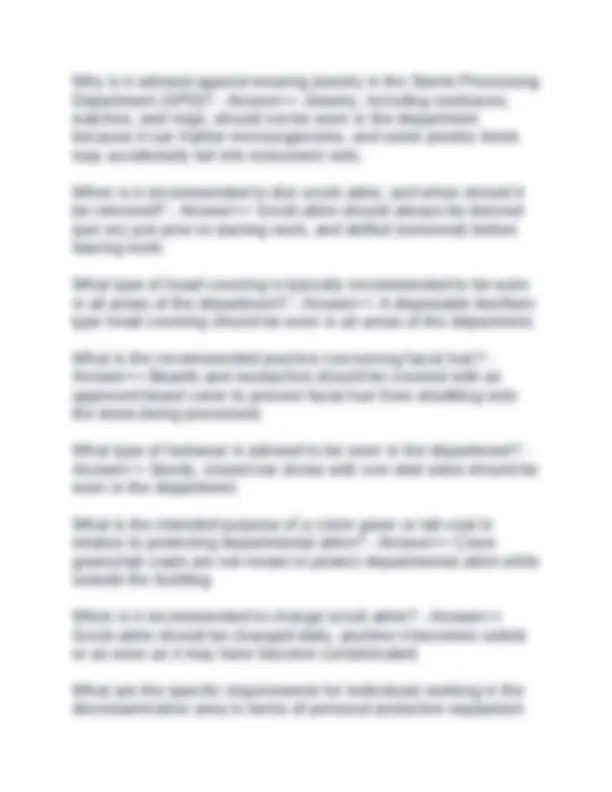
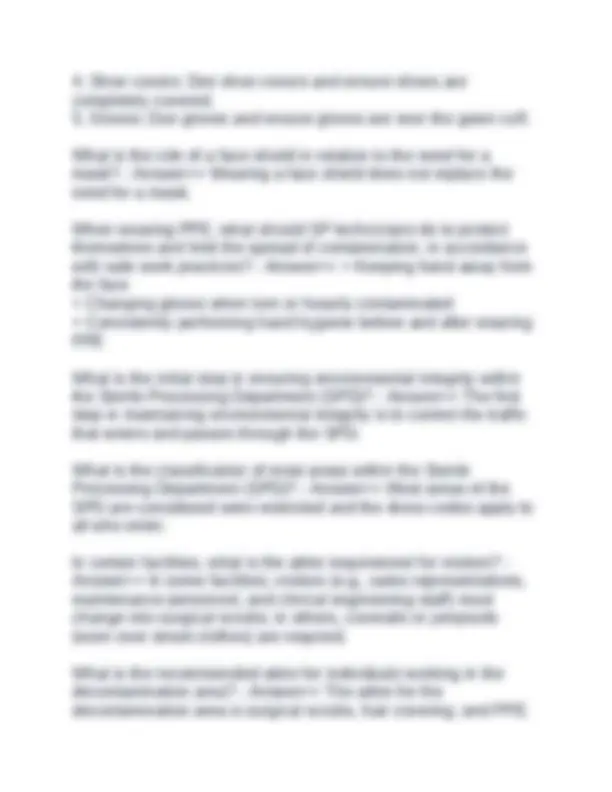
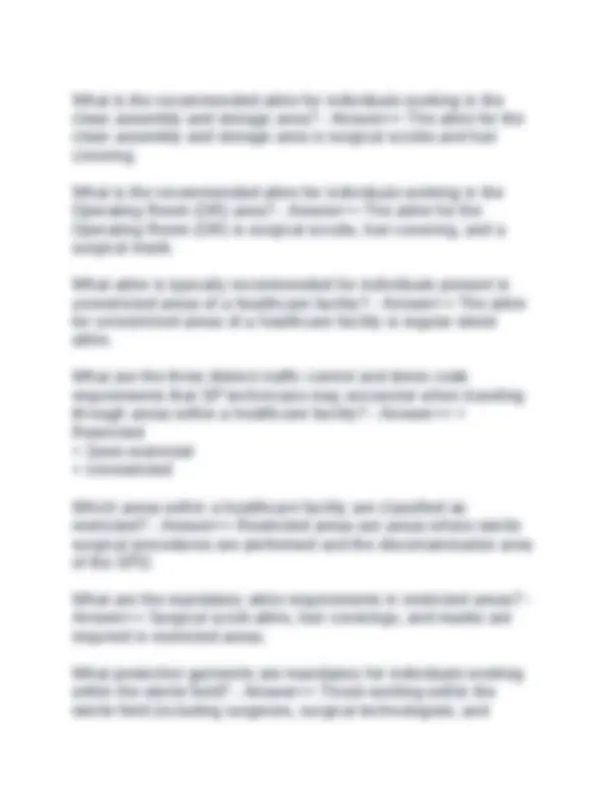
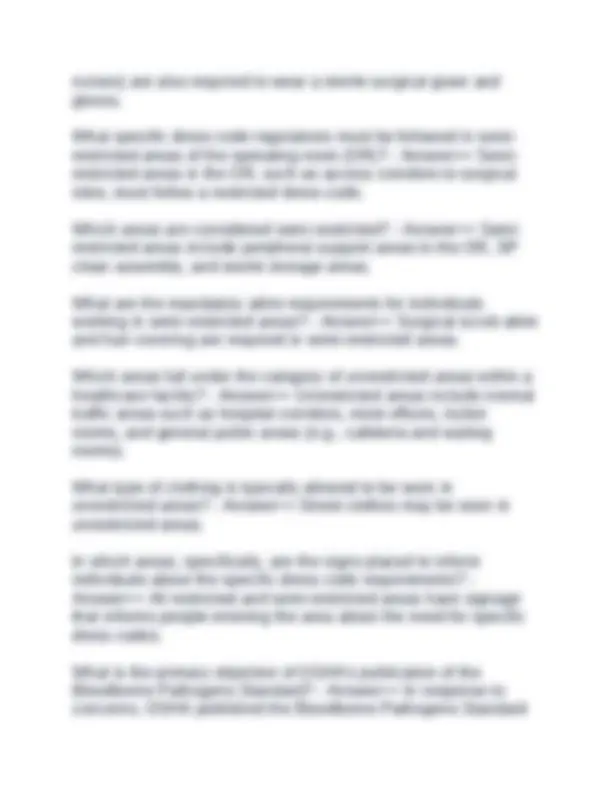
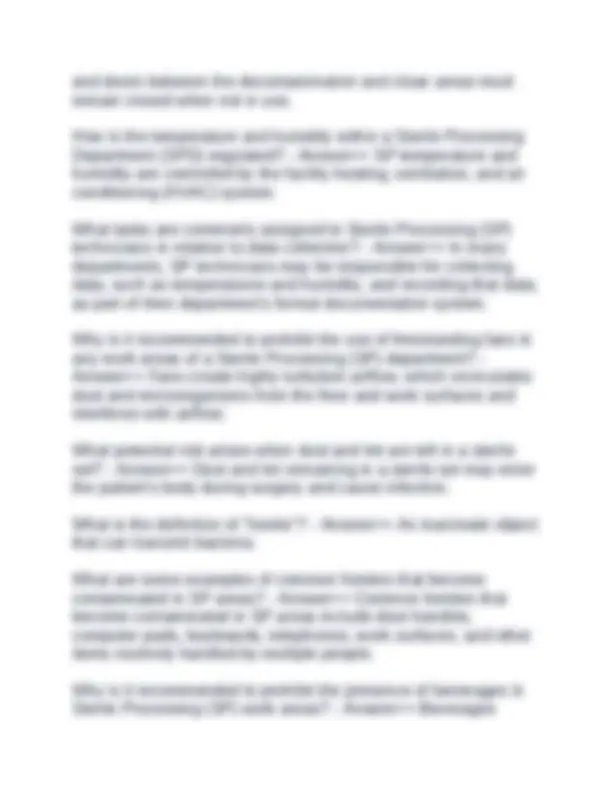
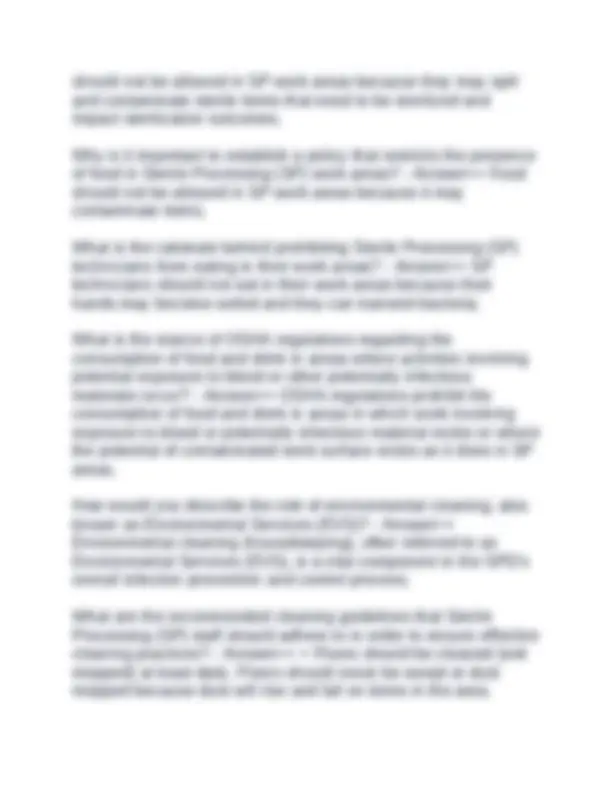
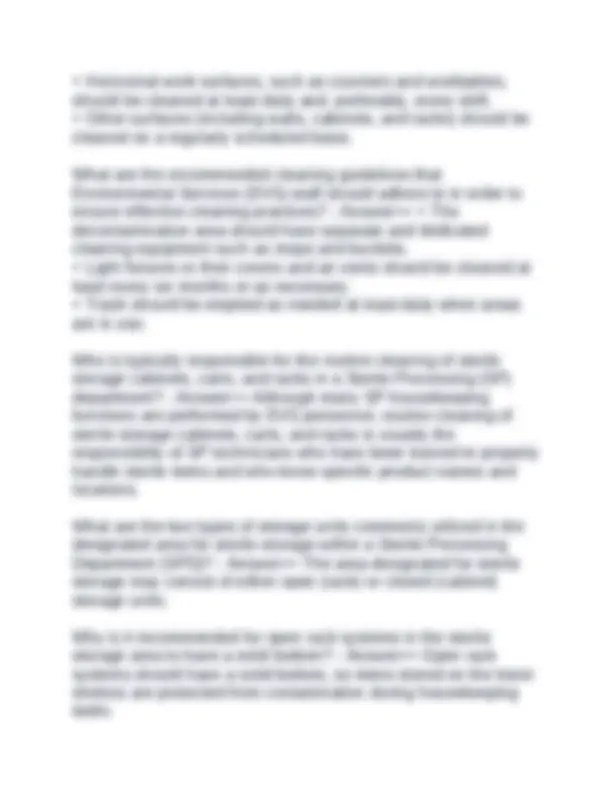
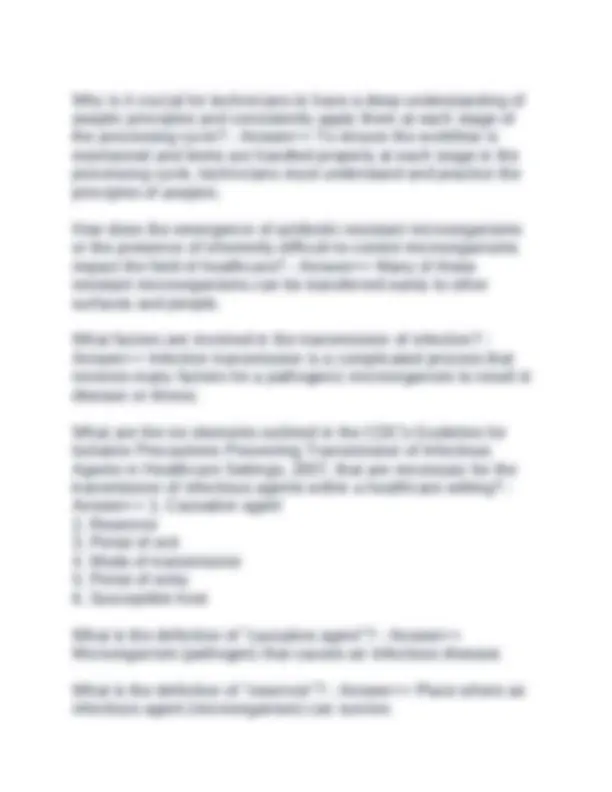

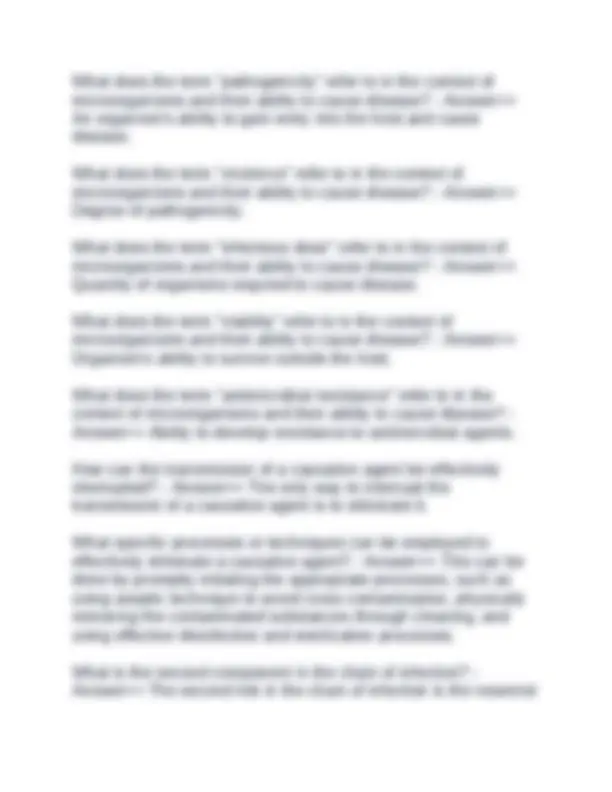
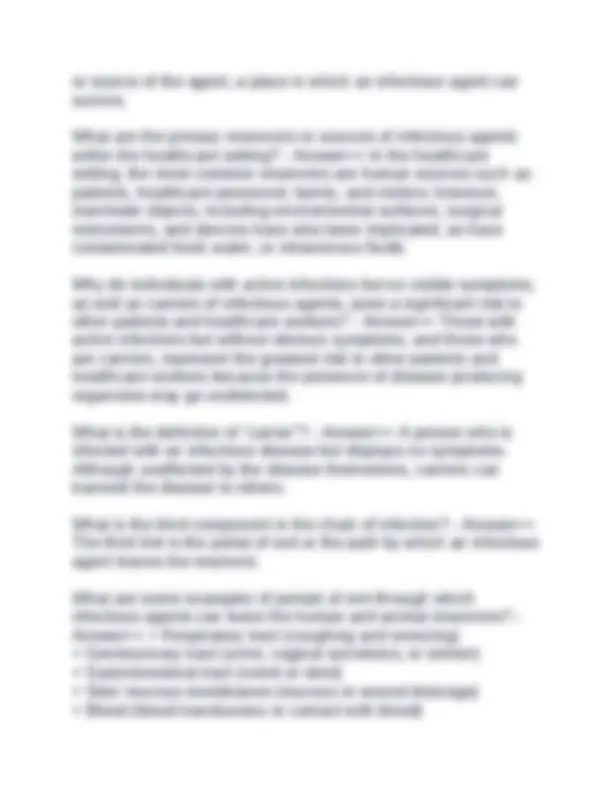
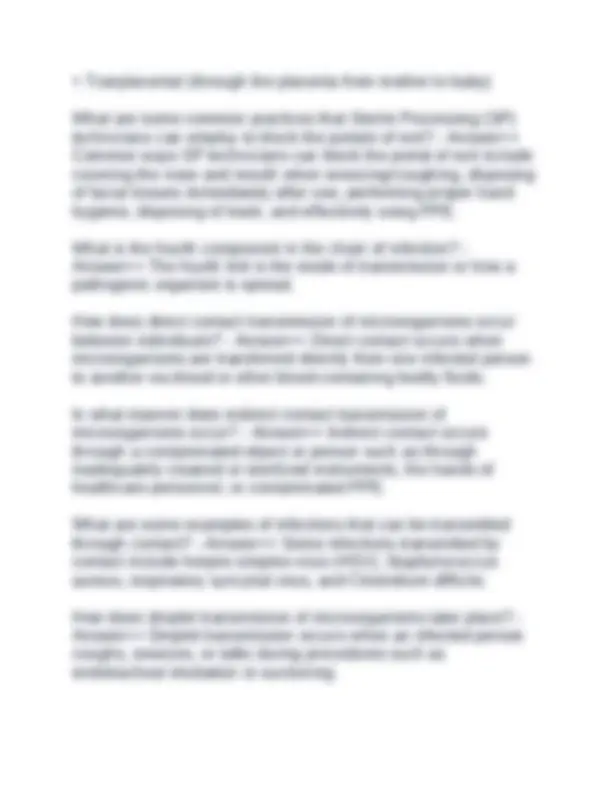
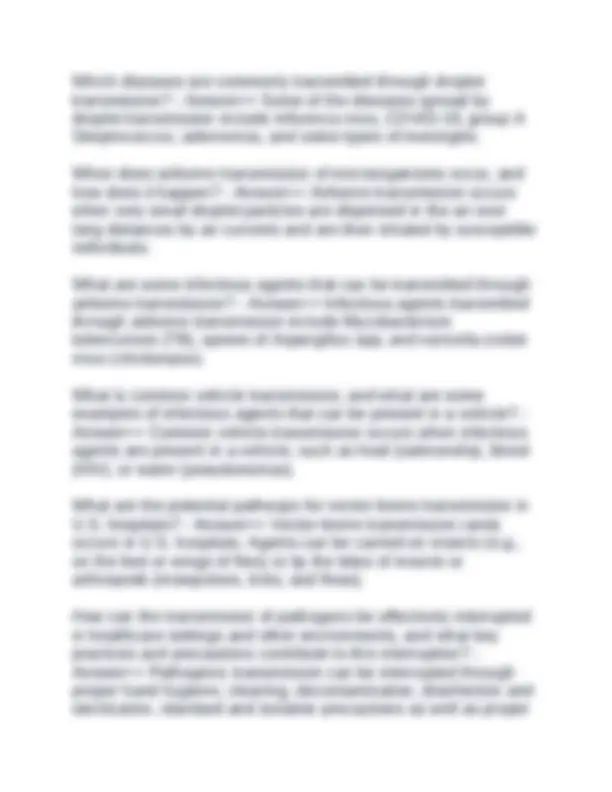
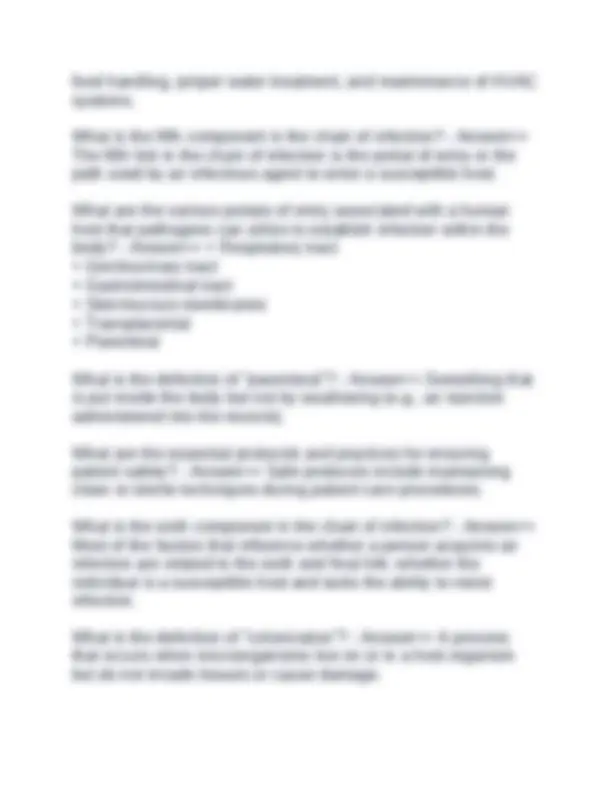
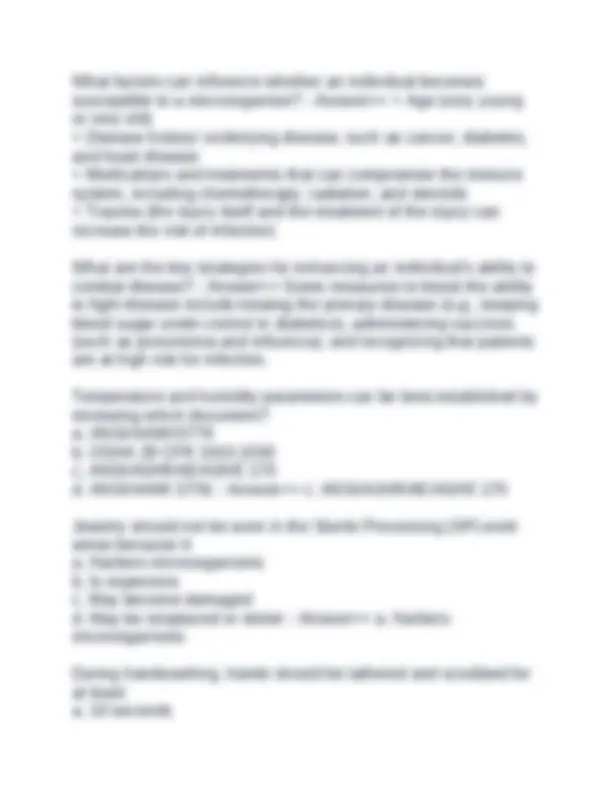
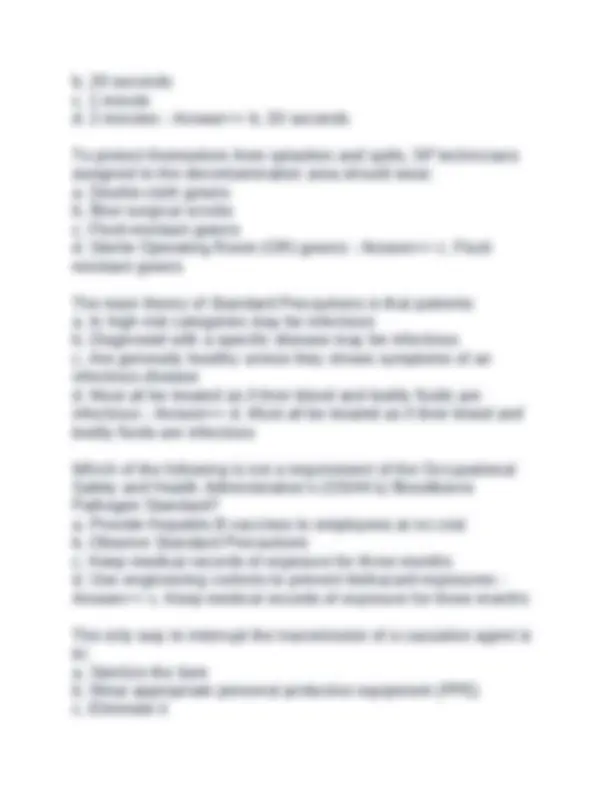
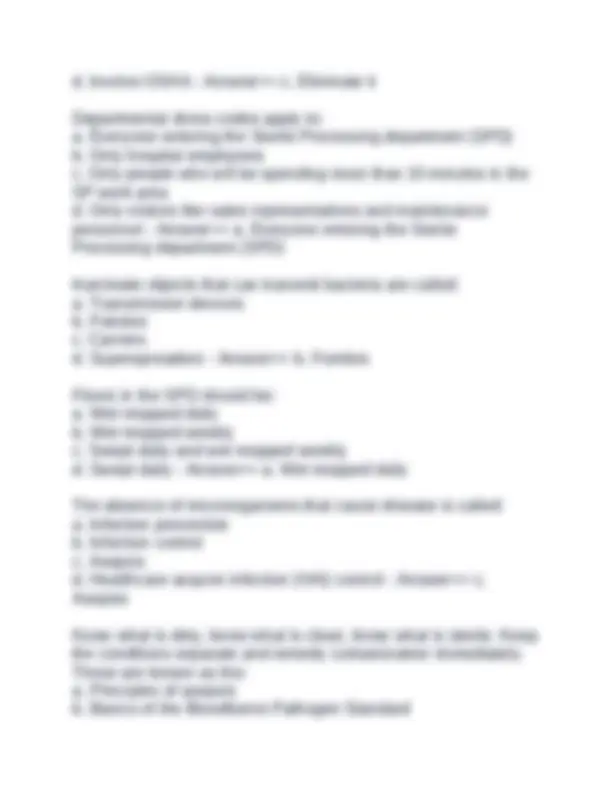
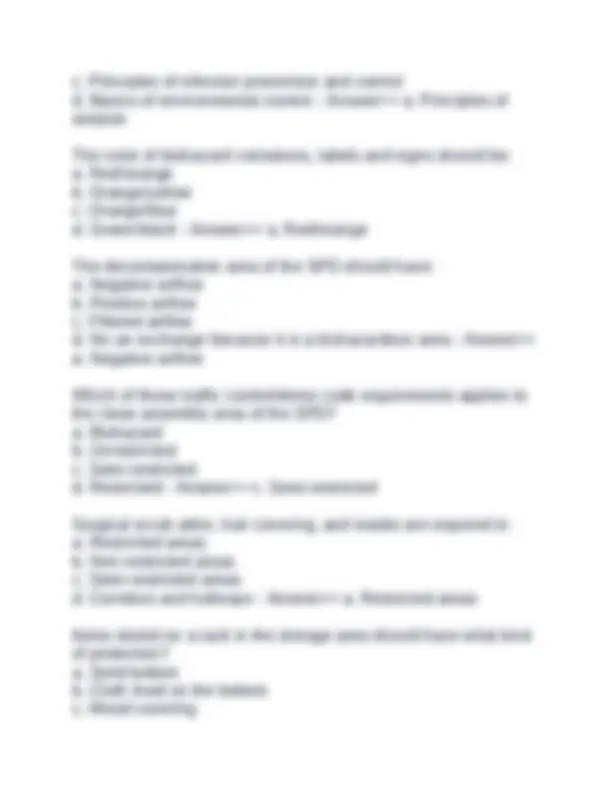
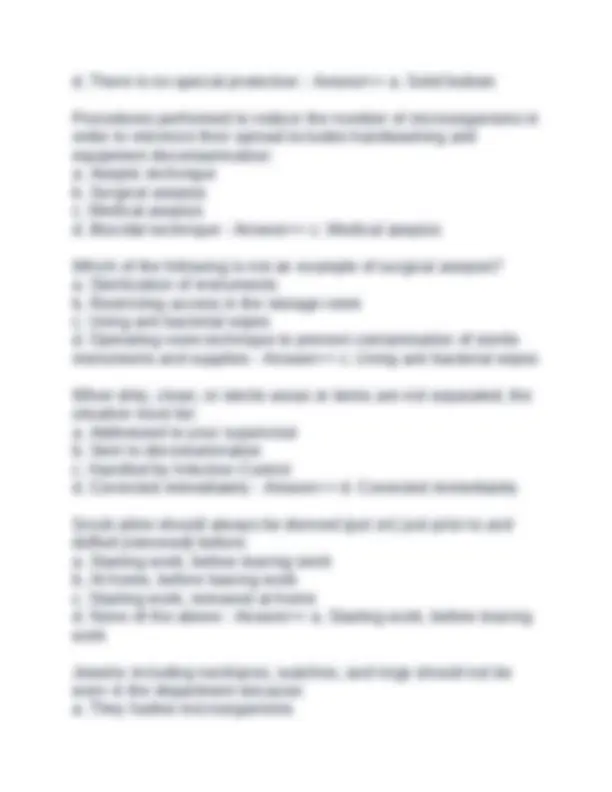



Study with the several resources on Docsity

Earn points by helping other students or get them with a premium plan


Prepare for your exams
Study with the several resources on Docsity

Earn points to download
Earn points by helping other students or get them with a premium plan
Community
Ask the community for help and clear up your study doubts
Discover the best universities in your country according to Docsity users
Free resources
Download our free guides on studying techniques, anxiety management strategies, and thesis advice from Docsity tutors
Sterile Processing Technical Manual - Chapter 5: Infection Prevention HSPA 9th Edition Review Questions and Answers 100% Pass | Graded A+
Typology: Exams
1 / 33

This page cannot be seen from the preview
Don't miss anything!


























David Mungai [Date] [Course title]
Sterile Processing (SP) technicians play a significant role in the prevention of which types of infections? - Answer>> The Sterile Processing (SP) technician plays a significant role in the prevention of surgical site infections (SSIs) and healthcare- associated infections (HAIs). What is the definition of "surgical site infection"? - Answer>> An infection that occurs after surgery in the part of the body where the surgery took place. How do Sterile Processing technicians support infection prevention efforts? - Answer>> ‣ Cleaning contaminated medical devices to make them safe for handling and prepare them for a biocidal process. ‣ Inspecting instruments to help ensure they are safe and functional. ‣ Assembling and packaging instruments in a manner that facilitates the chosen sterilization method, and providing a barrier after sterilization. ‣ Selecting and properly using the sterilization or high-level disinfection (HLD) method for each medical device. ‣ Safely storing items until they are needed and delivering them using methods that protect the integrity of the sterile packages and items that have undergone disinfection. ‣ Understanding how to apply infection prevention principles in sterile processing (e.g., preventing cross-contamination and recognizing hand hygiene moments).
In May 2016, how many cases of patient infections and deaths were reported at a Colorado hospital, which were linked to the endoscopic retrograde cholangiopancreatography (ERCP) endoscope, also known as the duodenoscope? - Answer>> In May 2016, nine newly reported cases involving the endoscopic retrograde cholangiopancreatography (ERCP) endoscope, more commonly known as the duodenosope, were linked to nine patient infections, resulting in three deaths at a hospital in Colorado. What is the foundation for infection prevention principles and practices? - Answer>> Infection prevention principles and practices are based on knowledge of the nature and characteristics of disease-producing microorganisms; this includes an understanding about how they are transmitted in the healthcare environment, and their place in the chain of infection. What is the definition of "chain of infection"? - Answer>> The six- step process of an infection spreading from one host to the next. What specific establishment or initiative was made by the CDC in the early 1970s? - Answer>> In the early 1970s, the CDC established the first practical recommendations for the isolation technique. What is the fundamental principle behind the adoption of standard precautions in healthcare settings? - Answer>> To protect healthcare staff and patients from infectious diseases, standard precautions were adopted; the basis of this is to treat all human blood, bodily fluids, and other potentially infectious materials as infectious. What is the consequence of not wearing the appropriate personal protective equipment (PPE)? - Answer>> Failure to wear the appropriate personal protective equipment (PPE) increases the individual's risk of acquiring an infection.
What is the primary objective of the Sterile Processing Department (SPD) in healthcare facilities? - Answer>> The primary purpose of the SPD is to stop the spread of disease- producing microorganisms to patients from instruments and other medical devices. How do Sterile Processing (SP) technicians contribute to the safety of items used in patient care and what specific methods do they utilize to achieve this goal? - Answer>> SP technicians must ensure that items used in patient care, including instruments, utensils, supplies, and equipment, are made safe by either cleaning, disinfection, or sterilization. What is the definition of "asepsis"? - Answer>> The absence of microorganisms that cause disease. What is the definition of "aseptic technique"? - Answer>> Any activity or procedure that prevents infection or breaks the chain of infection. How many distinct aseptic techniques exist, and what are their respective names? - Answer>> There are two types of aseptic techniques: ‣ Medical asepsis (clean technique) ‣ Surgical asepsis (sterile technique) What is the definition of "medical asepsis"? - Answer>> Clean technique; procedures performed to reduce the number of microorganisms and minimize their spread. What are some common examples of medical asepsis techniques that are used in the healthcare settings? - Answer>> Examples include handwashing and equipment decontamination.
What are the infection prevention and control goals of the Sterile Processing Department (SPD)? - Answer>> ‣ Eliminate or destroy all potentially infectious contaminants present on reusable instruments and equipment. ‣ Safely distribute reusable and single-use items required for the delivery of patient care. ‣ Establish and enforce standards for decontamination, disinfection, and sterilization in various healthcare settings. What are some essential components of infection prevention in the Sterile Processing Department (SPD)? - Answer>> Hygiene and adherence to dress code protocols are critical components of infection prevention in the SPD. What is the definition of "hand hygiene"? - Answer>> The act of washing one's hands with soap and water or using an alcohol- based hand rub. What specific action is widely acknowledged as the single most important factor in reducing the incidence of infections? - Answer>> Hand hygiene is considered the single most important factor in reducing infections. What are the correct steps or procedure for washing hands properly? - Answer>> 1. Remove all jewelry
Where does the foundation of infection prevention typically start?
Why is it advised against wearing jewelry in the Sterile Processing Department (SPD)? - Answer>> Jewelry, including necklaces, watches, and rings, should not be worn in the department because it can harbor microorganisms, and some jewelry items may accidentally fall into instrument sets. When is it recommended to don scrub attire, and when should it be removed? - Answer>> Scrub attire should always be donned (put on) just prior to starting work, and doffed (removed) before leaving work. What type of head covering is typically recommended to be worn in all areas of the department? - Answer>> A disposable bouffant- type head covering should be worn in all areas of the department. What is the recommended practice concerning facial hair? - Answer>> Beards and mustaches should be covered with an approved beard cover to prevent facial hair from shedding onto the items being processed. What type of footwear is advised to be worn in the department? - Answer>> Sturdy, closed-toe shoes with non-skid soles should be worn in the department. What is the intended purpose of a cover gown or lab coat in relation to protecting departmental attire? - Answer>> Cover gowns/lab coats are not meant to protect departmental attire while outside the building. When is it recommended to change scrub attire? - Answer>> Scrub attire should be changed daily, anytime it becomes soiled, or as soon as it may have become contaminated. What are the specific requirements for individuals working in the decontamination area in terms of personal protective equipment
(PPE) or dress code? - Answer>> Decontamination attire - The decontamination area is a restricted area, all individuals working in this area must comply with PPE or dress code requirements. Which organization established the requirement for compliance with personal protective equipment (PPE) or dress code in the decontamination area? - Answer>> This is required by the Occupational Safety and Health Administration (OSHA) and was established to help ensure workers are protected from potential pathogens. What types of personal protective equipment (PPE) are typically included in the decontamination process? - Answer>> ‣ Level 3 fluid-resistant gown, apron, or jumpsuit ‣ Fluid-resistant mask ‣ Goggles ‣ Face shield-full length and hoods ‣ Shoe covers ‣ Gloves approved for the decontamination area What is the rationale behind using a level-3 fluid-resistant gown as personal protective equipment (PPE), and what does it protect? - Answer>> A level 3 fluid-resistant gown provides a barrier against splash or spray and protects skin and scrubs. What is the rationale behind using a fluid-resistant mask as personal protective equipment (PPE), and what does it protect? - Answer>> Fluid-resistant masks are designed to provide protection for the mouth, nose, and chin, with the primary purpose of safeguarding the respiratory tract against airborne infectious aerosols. What is the rationale behind using goggles as personal protective equipment (PPE), and what does it protect? - Answer>> Goggles
What is the recommended attire for individuals working in the clean assembly and storage area? - Answer>> The attire for the clean assembly and storage area is surgical scrubs and hair covering. What is the recommended attire for individuals working in the Operating Room (OR) area? - Answer>> The attire for the Operating Room (OR) is surgical scrubs, hair covering, and a surgical mask. What attire is typically recommended for individuals present in unrestricted areas of a healthcare facility? - Answer>> The attire for unrestricted areas of a healthcare facility is regular street attire. What are the three distinct traffic control and dress code requirements that SP technicians may encounter when traveling through areas within a healthcare facility? - Answer>> ‣ Restricted ‣ Semi-restricted ‣ Unrestricted Which areas within a healthcare facility are classified as restricted? - Answer>> Restricted areas are areas where sterile surgical procedures are performed and the decontamination area of the SPD. What are the mandatory attire requirements in restricted areas? - Answer>> Surgical scrub attire, hair coverings, and masks are required in restricted areas. What protective garments are mandatory for individuals working within the sterile field? - Answer>> Those working within the sterile field (including surgeons, surgical technologists, and
(29 CFR 1910.1030) to recognize the potential for occupation exposure to bloodborne disease (hepatitis B and C; HIV). What is one of the key requirements of the Bloodborne Pathogens Standard in relation to an employer's responsibility to protect workers from occupational exposure to bloodborne diseases? - Answer>> The Bloodborne Pathogens Standard requires a written exposure control plan (ECP) that summarizes the employer's program for the protection of workers from occupational exposure to bloodborne diseases. What are the components or elements included in the written exposure control plan (ECP) mandated by the Bloodborne Pathogens Standard? - Answer>> ‣ The use of fluorescent orange or orange-red biohazard labels to identify contaminated items. ‣ Disposal of all sharps items in a rigid, puncture-proof container that are covered and properly labeled or color-coded. ‣ Transport of reusable sharps in enclosed carts or hard-sided containers to prevent injury. ‣ Hepatitis B vaccination ‣ Recordkeeping: Proof of training upon initial hire and annually thereafter. Medical records regarding any exposure must be maintained. ‣ Housekeeping: Provision of a clean and sanitary working environment, including regularly scheduled cleaning using hospital germicides (disinfectants) approved by the EPA. ‣ Policies and procedures to prevent occupational exposure and transmission of bloodborne pathogens. ‣ Implementation of various methods of exposure control, including following Standard Precautions such as the proper use of PPE; the use of engineering controls to physically remove hazards; and the development of work practice controls.
What is a fundamental aspect to consider in the physical design of a Sterile Processing Department (SPD)? - Answer>> An SPD's physical design should incorporate a clear separation of clean and dirty, and workflow patterns should be designed that create a one-way flow of goods from dirty to clean. What is an important design consideration for the decontamination area in a Sterile Processing Department (SPD)?
should not be allowed in SP work areas because they may spill and contaminate sterile items that need to be sterilized and impact sterilization outcomes. Why is it important to establish a policy that restricts the presence of food in Sterile Processing (SP) work areas? - Answer>> Food should not be allowed in SP work areas because it may contaminate items. What is the rationale behind prohibiting Sterile Processing (SP) technicians from eating in their work areas? - Answer>> SP technicians should not eat in their work areas because their hands may become soiled and they can transmit bacteria. What is the stance of OSHA regulations regarding the consumption of food and drink in areas where activities involving potential exposure to blood or other potentially infectious materials occur? - Answer>> OSHA regulations prohibit the consumption of food and drink in areas in which work involving exposure to blood or potentially infectious material exists or where the potential of contaminated work surface exists as it does in SP areas. How would you describe the role of environmental cleaning, also known as Environmental Services (EVS)? - Answer>> Environmental cleaning (housekeeping), often referred to as Environmental Services (EVS), is a vital component in the SPD's overall infection prevention and control process. What are the recommended cleaning guidelines that Sterile Processing (SP) staff should adhere to in order to ensure effective cleaning practices? - Answer>> ‣ Floors should be cleaned (wet mopped) at least daily. Floors should never be swept or dust mopped because dust will rise and fall on items in the area.
‣ Horizontal work surfaces, such as counters and worktables, should be cleaned at least daily and, preferably, every shift. ‣ Other surfaces (including walls, cabinets, and racks) should be cleaned on a regularly scheduled basis. What are the recommended cleaning guidelines that Environmental Services (EVS) staff should adhere to in order to ensure effective cleaning practices? - Answer>> ‣ The decontamination area should have separate and dedicated cleaning equipment such as mops and buckets. ‣ Light fixtures or their covers and air vents should be cleaned at least every six months or as necessary. ‣ Trash should be emptied as needed at least daily when areas are in use. Who is typically responsible for the routine cleaning of sterile storage cabinets, carts, and racks in a Sterile Processing (SP) department? - Answer>> Although many SP housekeeping functions are performed by EVS personnel, routine cleaning of sterile storage cabinets, carts, and racks is usually the responsibility of SP technicians who have been trained to properly handle sterile items and who know specific product names and locations. What are the two types of storage units commonly utilized in the designated area for sterile storage within a Sterile Processing Department (SPD)? - Answer>> The area designated for sterile storage may consist of either open (rack) or closed (cabinet) storage units. Why is it recommended for open rack systems in the sterile storage area to have a solid bottom? - Answer>> Open rack systems should have a solid bottom, so items stored on the lower shelves are protected from contamination during housekeeping tasks.